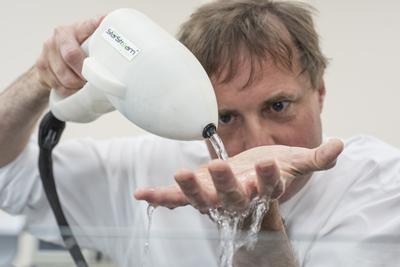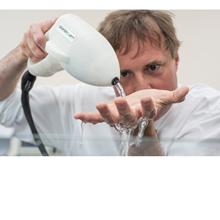Research reveals latest impact of carbon dioxide dissolving into ocean water
.jpg_SIA_JPG_fit_to_width_INLINE.jpg)
A new study led by the University of Southampton has shown that the transfer of gases across the sea surface affects the accumulation of greenhouse emissions in the atmosphere.
The transfer is typically viewed as a simple stirring process, but it becomes complicated when waves break on the sea surface in strong winds. The role of the ocean in contributing to climate control and change has been recognised for many years.
The study was published as part of a collaboration between Professor Tim Leighton, his PhD student Dr David Coles and Professor Paul White and at the University of Southampton’s Institute of Sound and Vibration Research, Professor Meric Srokosz from the National Oceanography Centre and Dr David Woolf from Heriot-Watt University.
The research found new measurements in the open ocean, including the first demonstration that substantial numbers of fairly large bubbles are injected by breaking waves to depths of at least one metre.
Published in Scientific Reports, the findings are crucial since these bubbles tend to partially dissolve, forcing additional carbon dioxide into the oceans. The inclusion of this effect increases current global estimates of the oceanic sink of carbon dioxide and rates of ocean acidification.
Professor Tim Leighton, Principal Investigator for the study, said: “If the amount of carbon dioxide dissolving into the seas from the atmosphere exactly balanced the amount leaving the seas and entering the atmosphere we would have a steady state situation.
“However, our data suggests that in stormy seas the bubble-induced asymmetry in atmospheric carbon dioxide dissolving into the oceans, as compared to previously dissolved carbon dioxide being released back into the atmosphere, is many times greater than scientists currently estimate.
“The excess CO2, which gas dissolves into stormy seas through bubbles, will increase as the proportion of CO2 in the atmosphere increases.”

The results of the study, titled ‘Asymmetric transfer of CO2 across a broken sea surface’, indicate a much larger imbalance of carbon dioxide than previously suggested, contradicting an assumption inherent in most existing estimates of ocean atmosphere gas transfer.
Moreover, the geochemical and climate implications include increased levels of carbon dioxide into stormy, temperate and polar seas.
Dr David Woolf from Heriot-Watt University applied his expertise in modelling the processes of air-sea gas exchange within the project and comments: “The role of bubbles in the air-sea exchange of gases has been of interest for decades, but firm conclusions have been prevented by a lack of adequate data. Participation in this project has been very rewarding since measurements are finally giving us the information we need.”
Professor Leighton added: “This was a tremendous study stretching right from theory to the design of new sensors and sea-going platforms to hold them, with years of careful calibration in the lab to ensure the measurements were accurate, and the development of a comprehensive model of bubble clouds under breaking waves in the upper regions of the ocean, and how they affect the flux of gases between atmosphere and ocean.
“We achieved this thanks to funding from the Natural Environment Research Council. After a couple of years of preparation, we went to sea in 2007 in very rough conditions, and since then have been carefully analysing the data and writing this report, before determining these conclusive findings."
The research team have passed on all of their methods, equipment, computer codes, and findings to other groups around the UK for further investigation.
